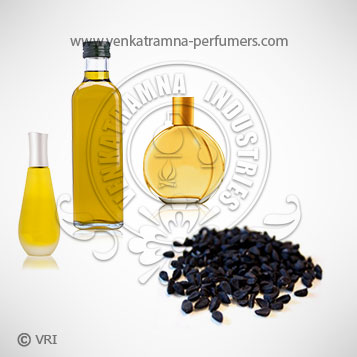
| Botanical Name | Carum carvi |
| Common Name | Black Cumin oil, Habbat-ul Barakah, Blessed Seed oil. |
| Country of Origin | India |
| Solubility | Soluble in Alcohols, Essential Oils and insoluble in water |
| Specific Gravity | 0.90000 to 0.93500 @ 25.00 °C |
| Optical Rotation | +3.00 to +8.00 |
| Refrective Index | 1.50100 to 1.50600 @ 20.00 °C. |
| PlantPart | Seed |
| Bland With | Sandalwood Oil & Ylang ylang |
| CAS No | 8014-13-9 |
| Flash Point | 89 °C. |
| Extraction Method | Extraction |
Black Cumin Seed Oil is taken from an annual herbaceous plant that is member of Ranunculaceae (buttercup) family. The fruit of plant, the black seeds is used for extracting the oil. Black seed contains over 100 valuable nutrients including significant proportions of protein, carbohydrates and essential fatty acids. Nigella sativa black-caraway, also known as nigella (or kalonji), often called black cumin, is an annual flowering plant in the family Ranunculaceae, native to south and southwest Asia. Nigella sativa grows to 20-30 cm (7.9-11.8 in) tall, with finely divided, linear (but not thread-like) leaves. The flower is delicate, and usually colored pale blue and white, with five to ten petals. The black caraway fruit is a large and inflated capsule composed of three to seven united follicles, each containing numerous seeds which are used as spice, sometimes as a replacement for black cumin.
In use for over 4,000 years, Cumin was mainly used for its digestive properties and as a spice. The ancient Greeks and Romans used it much as we use black pepper. In the Holy Land, people used it to pay their debts and taxes with it. In the Middle Ages, feudal lords sometimes paid their serfs with Cumin for services rendered, before it fell out of favor with Europeans as a spice; at the same time, it began to grow in popularity in South America. Black cumin seed oil has been used for health and wellness for thousands of years. In it, you’ll find vitamins, minerals, essential fatty acids and even compounds that improves cell growth. It’s been called a veritable fountain of youth. Black cumin seeds come from a plant called Nigella sativa. The plant is sometimes called black caraway or fennel flower too, and it’s a totally different plant from the cumin that you normally cook with. That kind of cumin comes from Cuminum cyminum and is related to parsley. Archaeological evidence about the earliest cultivation of N. sativa “is still scanty”, but N. sativa seeds were found in several sites from ancient Egypt, including Tutankhamun’s tomb. Seeds were found in a Hittite flask in Turkey from the second millennium BCE.
Color : Clear Blackish Yellow Liquid with Good and Typical Black Cumin odor,
Aroma : Spicy, penetrating scent.
thymoquinone, nigellone, oleic acid, linoleic acid, calcium, iron, potassium, zinc, selenium, magnesium, vitamin A, vitamin B, niacin, vitamin B2 and vitamin C.
It is used for treating respiratory & digestive problems, parasites & inflammation. Further, it also helps in health conditions including colds, headaches, infections and toothaches. Black cumin is used as a remedy for dry skin, skin diseases, dandruff and wounds. In Ayurveda, Black Cumin Seed Oil has been used in a wide range of applications, mainly for its stimulating, warming, and tonic properties as well as for its uplifting effect on the mood. Traditionally, it was used to address health conditions such as anorexia, sexually-transmitted diseases, and gynaecological ailments. It was also believed to be beneficial for stimulating the appetite and metabolism, easing neurological disorders, positively enhancing negative temperaments, and promoting harmony within the body and mind. Used medicinally, Black Cumin Seed Oil works as an antiseptic and anti-bacterial agent that eliminates harmful topical bacteria while preventing their future growth, thus proving to stimulate a strong immune response. With anti-inflammatory and soothing properties, it soothes skin and facilitates its healing process to effectively address conditions such as eczema and psoriasis. Its analgesic properties make it ideal for reducing the discomforts of rheumatism.